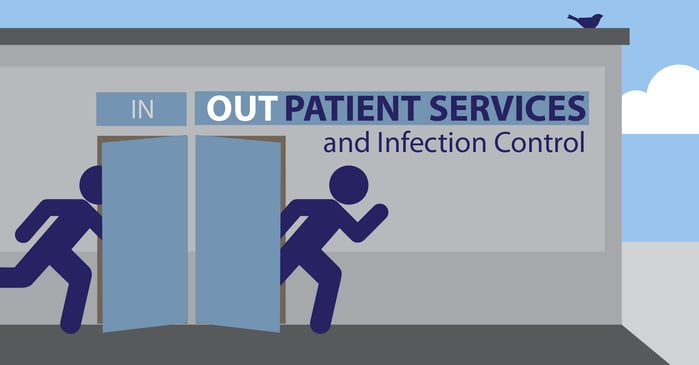Outpatient Services and Infection Control: Moving Forward [Part 5]
![Outpatient Services and Infection Control: Moving Forward [Part 5]](https://blog.eoscu.com/hs-fs/hubfs/Small_Blog_Headers/Outpatient_Services-01.jpg?width=950&name=Outpatient_Services-01.jpg)

This series on outpatient services and infection control can seem rather dismal. Thankfully, most outpatient facilities are safe and only a small percentage of patients experience an HAI. Nonetheless, the breaches in infection control mean that given the right circumstances, severe outbreaks can (and do) take place. The reality can make us feel powerless and confused. Fortunately, there are things that we can do to help.
First, let’s look at some concrete things that can be improved. What is the solution to the issue of infection prevention in ambulatory care facilities? Experts seem to agree on a few things:
-
A certified infection prevention specialist on staff or on contract. Facilities that receive Medicare funding are required to have someone on staff that deals with infection prevention (with training, not certification), but not full-time. Those facilities that operate independent of state and federal regulation have no such requirement. Studies show how critical a dedicated infection prevention team is to a hospital’s success with preventing HAIs: A team to run hand hygiene programs, train new staff, record and analyze data, etc. It should be no different in an ambulatory care setting.
-
An up-to-date, site-specific infection prevention plan, including how to report possible errors or outbreaks. Shockingly, many ambulatory care facilities do not have an infection prevention plan that clearly states the expectations, responsibilities, and requirements for their specific facility. While these facilities may have checklists to follow for accreditation or the CDC’s guide on site, it is not customized to the specific equipment, layout, demographic needs, or other unique characteristics of that facility.
-
Regular training, monitoring, and reporting of proper injection techniques. This is the number one infection prevention lapse in ambulatory settings. Not only does the CDC reported list of outbreaks demonstrate how common these mistakes are, many experts in the field report the appalling injection errors they see regularly. These mistakes include using the same syringe for multiple patients, re-inserting a used needle into a medicine vial, using single-use medicine vials for multiple patients, or not labeling medicine vials properly. For this reason, the CDC has launched the One and Only Campaign.
-
Regular training, monitoring, and reporting of proper device disinfection and sterilization procedures. Staff must be trained to use autoclaves, cold disinfection trays, and other equipment regularly. Instructions and manuals must be physically present and up-to-date. Rules about what devices can and cannot be process on-site must be posted.
As the CDC states in their guide, “outbreaks and other adverse events were associated with breakdowns in basic infection prevention procedures.” In fact, these lapses appear so common that it is only through sheer luck that more outbreaks have not taken place. On the flip side, basic infection prevention procedures are comparatively easy to implement and enforce.
So what can YOU do?
If you or a loved one choose to have a procedure at an ambulatory care facility, keep these suggestions in mind.
Make sure that it is accredited.
Take a tour of the facility and ask about their infection prevention policy.
On the day of the procedure, keep an eye out for hand hygiene practices, ask that your nurse or healthcare worker open your syringe in your presence and uses a new syringe for each injection. (Not just a new needle.)
Take careful note of the wound care instructions you receive before you are sent home. Ask any questions you may have, and call the facility if you have any more questions when you are home.
Another thing we can all do is advocate for improved oversight of ambulatory care centers in our state. Find out what your state’s laws and regulations are, and if they are weak or non-existent, contact your representative and find out why. Email your city council or state representatives the CDC’s “Outpatient Settings Policy Options for Improving Infection Prevention” guide and ask them to consider taking up the issue with their colleagues. Every voice counts in this effort to improve healthcare.
We hope you learned some helpful information from this series on infection control in ambulatory care facilities.
Read the Full Series
|
|
| Part 1: What are Outpatient Services? | Part 4: Tracking Infections |
| Part 2: What is Ambulatory Care? | Part 5: Room for Improvement |
| Part 3: Outbreaks & Reporting | |
Editor's Note: This post was originally published in March 2016 and has been updated for freshness, accuracy and comprehensiveness.
![EOScu Logo - Dark - Outlined [07182023]-01](https://blog.eoscu.com/hubfs/Eoscu_June2024/Images/EOScu%20Logo%20-%20Dark%20-%20Outlined%20%5B07182023%5D-01.svg)

![Outpatient Services and Infection Prevention: What We Don't Know is Hurting Us [Part 3]](https://blog.eoscu.com/hs-fs/hubfs/Small_Blog_Headers/Outpatient_Services-01.jpg?height=500&name=Outpatient_Services-01.jpg)

